Tender pieces of flavorful pork glazed with a sweet and savory sauce and fresh off the grill–these pork BBQ skewers are so mouth-watering that you’ll want to hoard them all on your plate. It’s no wonder these are a Filipino delicacy.
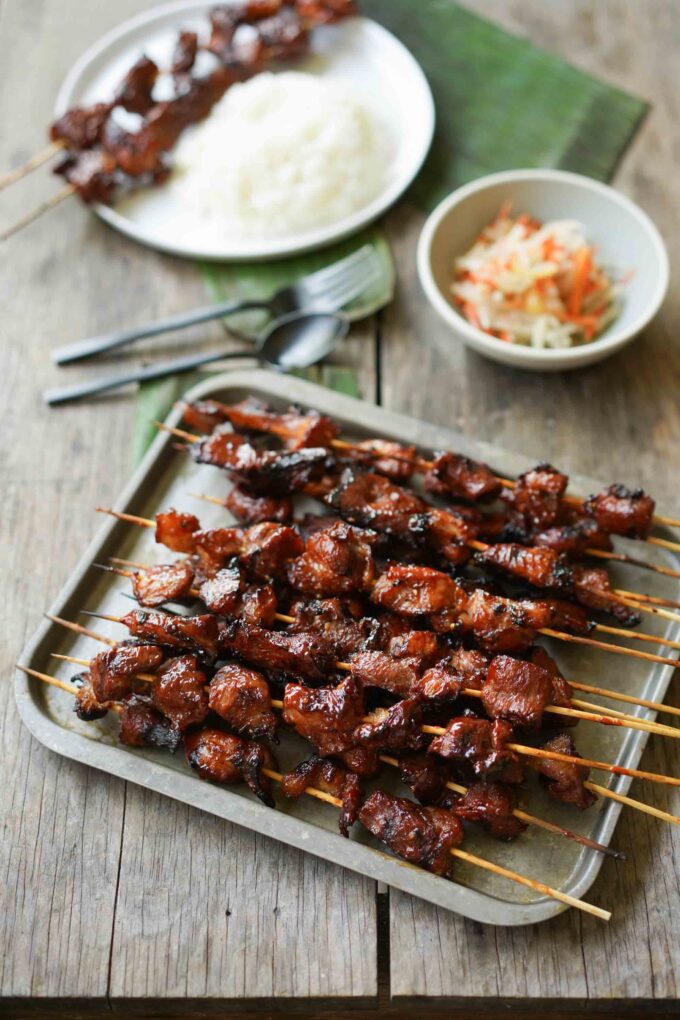
What pork and BBQ means to Filipinos
BBQ and grilling in the Philippines is a large part of cooking and food culture. When I visited the Philippines almost a decade ago, I really enjoyed a lot of street food in Cebu and Manila. Many of these street foods were grilled and BBQed as soon as you ordered them and took them to go.
You could even purchase rice on the go in the form of pusô–hanging rice that is formed by weaving palm leaves into a diamond-shaped, adding rice, and steaming it. Puso paired along with BBQ skewers in a brown paper bag was the perfect on the go meal.
These are food experiences I also have luckily been a part of in the US. If you’ve ever been able to attend a Filipino party (or even better, a boodle fight) in America, you should expect a lot of grilled and BBQ foods, like chicken inasal, lechon belly, and my favorite, pork BBQ skewers.
It shouldn’t be a complete surprise that pork is a quintessential part of Filipino food and culture, especially because pigs are an indigenous animal to the Philippines. Historically, it was known that pigs were given as offerings to Gods. While not all Filipinos or Filipino Americans eat or love pork, there is still interesting data on pork consumption in the Philippines. In 2017, the average Filipino consumed over 30 pounds of pork annually (compared to the 28 pounds of pork consumed by the rest of the world).
Filipino vs American BBQ
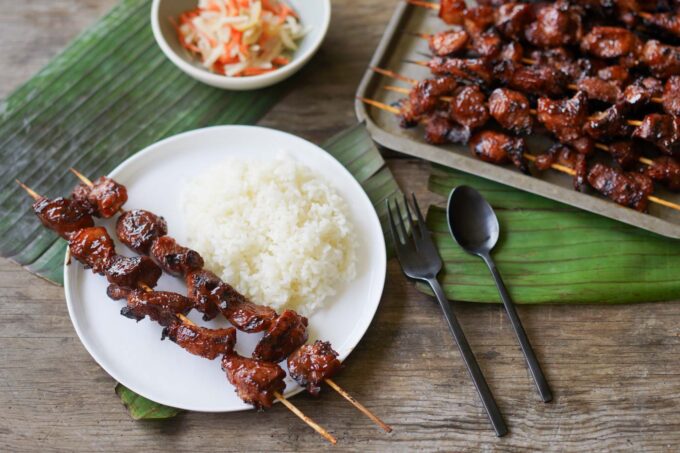
Filipino BBQ shares some similarities with American BBQ, and it’s equally as tasty and satisfying. Typically Filipino BBQ is cooked over charcoal, but these days gas is also used in restaurants and homes, too. While many American marinades for BBQ rely on dry rubs or thick sauces you add on after it’s cooked, Filipino BBQ often uses wet marinades that include ingredients specific to Filipino cuisine.
For example, many marinades use 7-up or Sprite as a way to tenderize the meat or using banana ketchup as a sweetener. I like to use banana ketchup in both the marinade and the glaze while cooking. For Filipino Americans, I’ve started to see a lot of interesting fusions made in Filipino BBQ–something that is reflected in this recipe.
What is banana ketchup?
Banana ketchup can be something of a mystery to those who didn’t grow up with it because most people have only heard of tomato ketchup. Basically it’s a condiment that is a combination of bananas, sugar, garlic, and red food coloring–there’s actually no tomatoes in this condiment at all.
You can find banana ketchup in many Filipino and Filipino American homes. It was influenced by American style ketchup during colonization. You can eat it with your eggs and rice or add it in a marinade, like this recipe.
But what does it taste like? Well, to me it tastes much sweeter than it is tangy like traditional tomato ketchup, but you also can’t taste the actual banana flavor. Some brands even have spicy versions available. You can find my preferred brand, Jufran, at many local Asian grocery stores or online because of it’s long shelf life.
The marinade
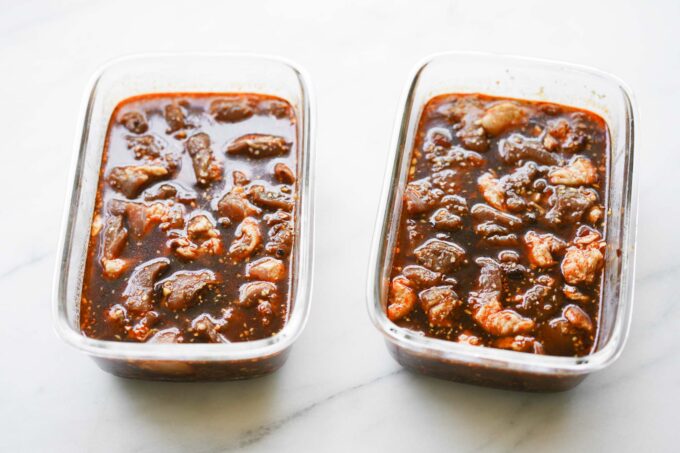
For pork BBQ skewers, many traditional marinade recipes will include a combination of 7-up (or Sprite), soy sauce, vinegar, brown sugar, garlic, and banana ketchup. After making these skewers many times throughout the past, I wanted to add some additional ingredients to amplify the taste.
In this recipe, I added chili oil with black bean sauce to add a bit of a kick instead of using fresh chilis. If you don’t have this sauce at home, you can use fresh chilis or omit completely. I also used a Filipino brand of vinegar called Datu Puti, which is a sweet type of vinegar with less acidity. If you don’t have this at your local market, you can use regular distilled vinegar.
In a large mixing bowl, add banana ketchup, 7-up (or sprite), soy sauce, vinegar, oyster sauce, chili oil with black bean sauce, brown sugar, ground pepper, and lots of garlic. Mix the ingredients thoroughly before adding your pork.
The meat
When picking pork, I like to choose pork shoulder or butt because it’s got a nice combination of lean and fatty pieces–perfect for bbq and many other dishes like sweet and sour pork.
My local grocery stores also sell it relatively cheaper than pork belly, too. At home, cut your pork shoulder into cubes no smaller than one inch on all sides. I like to make sure that all the pieces have some parts of the fat in them so that each bite is tasty.
Once you’ve cut the cubes, add them into an air-tight container and pour the marinade over the meat, making sure all pieces of the pork are covered. Marinate the pork for up to six hours in the fridge so you get all that sweet and savory goodness in each piece of pork.
The glaze
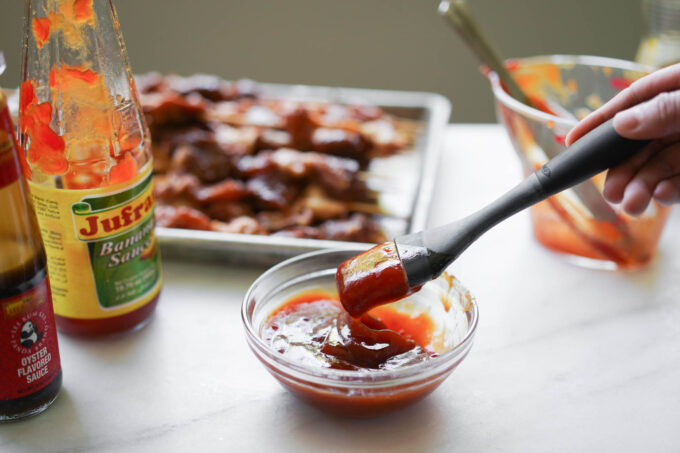
Right before grilling, make the glaze by combining banana ketchup, oyster sauce, and sesame oil in a small mixing bowl. You will be glazing the skewers on the grill to add even more flavor.
Grilling
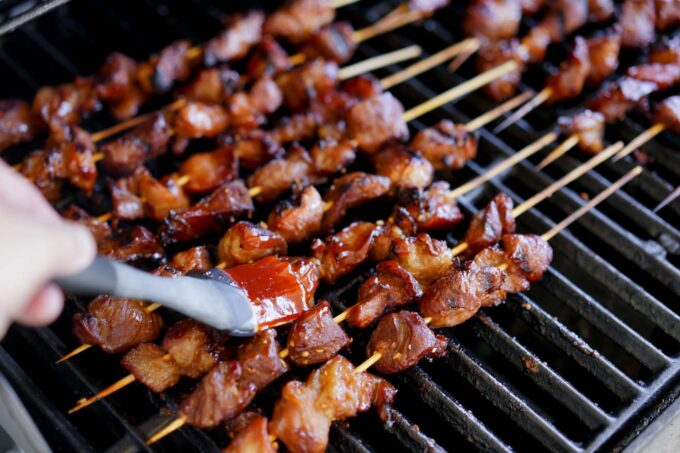
Traditionally, they use charcoal grills to cook the BBQ skewers, but if you only have a gas grill that will also work. Learn how to start a charcoal grill here. About 30 minutes before grilling, you want to soak your wooden BBQ skewers in water to prevent them from burning on the grill–this is important! I’ve had the wooden sticks catch fire because I didn’t soak them and it is not fun.
Also, make sure to remove your marinating meat from the fridge and rest it on the counter so it’s not too cold when grilling. You want to make sure they cook evenly.
When you’re done marinating and soaking your skewers, you can then add about five to six pieces of meat to each skewer. I like to alternate pieces that are more lean and then more fat so each stick gets an even proportion. In the Philippines, I noticed that they also add a piece of fatty pork at the end of the stick–almost like a treat at the end!
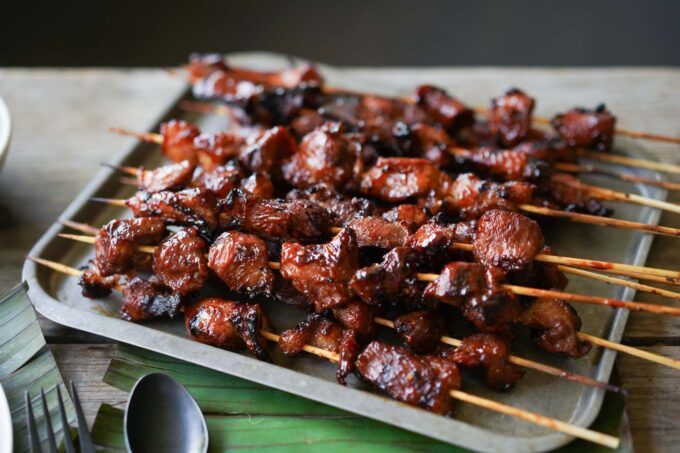
To prevent from immediately charring your skewers, keep it at about 80% heat when you place the skewers on the grill. Cook the skewers for about four minutes on each side and then turn it over and cook for another four minutes.
After cooking for about eight minutes, glaze one side and turn over to grill for another minute, and repeat on the next side. The cooking time can vary greatly depending on how large your cuts of meat are. You can use your thermometer to check the doneness (pork should be around 145 °F). Remove the skewers when they’re done.
Serving
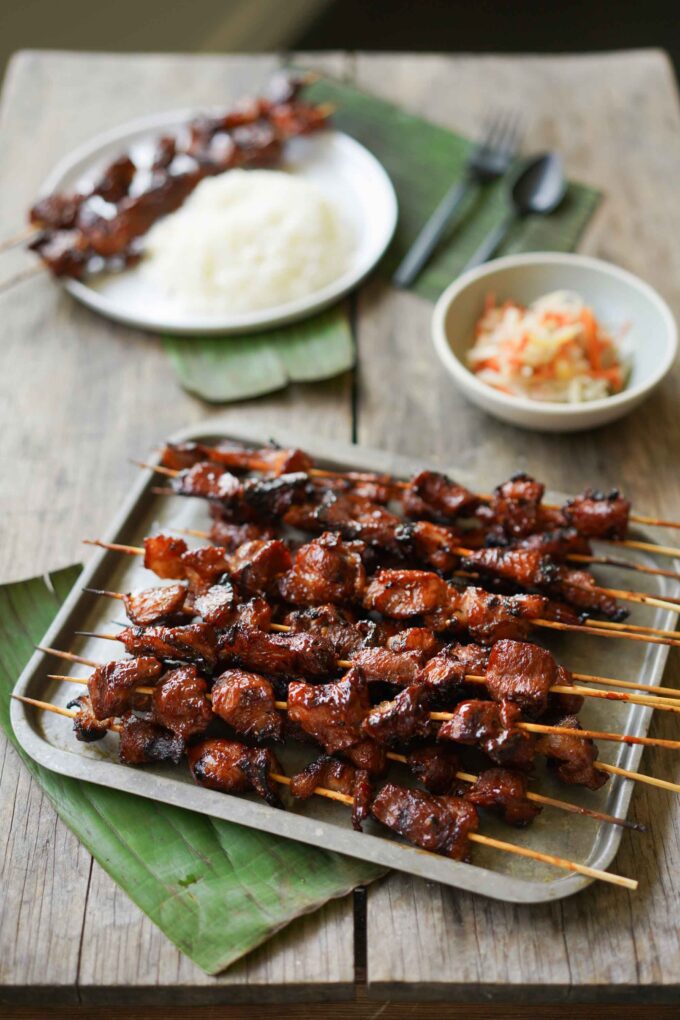
While pork BBQ skewers are traditionally served with a side of vinegar sauce made of vinegar, garlic, salt, and pepper, I often like to eat it with Filipino pickles called atchara.
Eat these skewers fresh off the grill kamayan style with a side of rice, some pickles, crispy lumpia, grilled corn in foil, and you will thank me later. As a kid, I even ate bbq pork skewers with pandesal as a sandwich, the options are endless!
For other types of bbq, I would recommend yakitori (or Japanese skewers), smoked salmon, 3-2-1 ribs, or grilled veggie kabobs for a healthier option.


Filipino BBQ Pork Skewers
Ingredients
Marinade
- 3 lb pork shoulder cut into one inch cubes
- ½ c banana ketchup
- 1 c 7-Up or Sprite
- 1 c soy sauce
- ½ c Datu Puti vinegar or white vinegar
- ¼ c oyster sauce
- 2 tbsp chili oil with black bean
- 1 c brown sugar
- 2 tsp ground pepper
- 1 c garlic minced
Other
- 16 (12-inch) bamboo skewers
Glaze
- ¼ c banana ketchup
- ⅛ c oyster sauce
- 1 ½ tbsp sesame oil
Equipment Used
- grill
Instructions
Marinade
- Cut the pork shoulder into cubes about one inch in size all around. Add the meat in an air-tight container larger than the amount of meat inside, leaving room for the marinade.
- In a large mixing bowl, combine the banana ketchup, 7-up, soy sauce, vinegar, oyster sauce, chili oil with black bean sauce, brown sugar, ground pepper, and garlic. Whisk the contents and make sure the brown sugar has dissolved.
- Pour the marinade over the meat and mix together to make sure all the meat is covered. Marinade for six hours and no more than eight hours, refrigerated.
Grilling
- Soak the bamboo skewers in water for at least 30 minutes. Remove the marinade from the fridge and let sit on the counter for 30 minutes to adjust the temperature before grilling (this is also easier on your hands when skewering).
- In a small bowl, combine the banana ketchup, oyster sauce, and sesame oil and mix thoroughly.
- Assemble the BBQ skewers by adding about five-six pieces of pork to each skewer. Try to alternate fattier and leaner pieces. Repeat until all pieces of meat are skewered.
- Preheat the grill to medium-high heat (about 80%). Place the skewers on the grill and cook for four minutes on one side before turning. Repeat cooking for another four minutes.
- Use a brush to baste the glaze on one side of the skewer, turn over the skewer, cook for one minute. Repeat basting and cooking. Check the temperature of the meat to see if it’s cooked thoroughly (145 °F). You can also use a knife to cut a piece of pork and check the center. Finish pork skewers should be slightly firm, but not dry and not translucent in the middle. Adjust cooking time if necessary or remove the skewers if they’re finished.
- Serve with a side of rice and sweet Filipino pickles.










Absolutely delicious!
Yess thank you Daniel!
Followed the recipe. The best!!! Thank you.
Thanks Jinky, glad you liked it!
Is 1 cop of garlic correct? Seems like a lot.
Yup its correct! feel free to scale it back if you’d like though 🙂
This is the best recipe yet! I think the glaze is what makes it so delicious. I haven’t seen a recipe with the glaze. I double the recipe to make sure I have enough for a few rotations. Also, balsamic vinegar taste really good with this as a dip for another layer of flavor. Thanks for sharing!
Thanks for the comment and the recipe tip Michelle!
My husband and I love it. The marinade is good in chicken bbq too
This is my new go-to bbq recipe. Living away from home (Philippines), this recipe brings nostalgia. It definitely tastes like the one that we used to buy before at the streets. This recipe is really really good!
Hi! What will happen if you marinate it for more than 8 hrs? I would like to try you recipe but the marination will be more than 8 hrs. Because i will marinate it today to be grilled tomorrow.😊
Hey Ellen, it may become too salty if you marinate too long.
I tried this recipe last Saturday and it was super delicious! Thank you😁
I’ve made Filipino BBQ a few times now, had it plenty at restaurants. It’s always good. But THIS recipe?! Absolutely the best I’ve had. THANK YOU
Can I do it without chili oil black bean?
Yes Leslee, you can make this without the chili oil black bean–you’ll lose a bit of the spice and flavor from the oil but overall it will still turn out tasty.
The best recipe! My family says it’s better than any Filipino restaurant in our area. Thank you!
I cannot thank you enough! This is literally the best recipe I have ever found on the internet.
Usually, if there’s a dish I want to prepare, I’m pretty successful at reverse engineering the recipe. However, with intricate dishes (like this one), I start with an internet recipe and adjust as needed. THIS recipe needed no adjustment whatsoever. Simply amazing!!!
Can leftover marinade be frozen and used later?
Thanks John! I haven’t tried it, but given what’s in the marinade, it might last in the freezer.
which datu puti white vinegar works best, i see there are different types?
For this recipe I use the plain one!